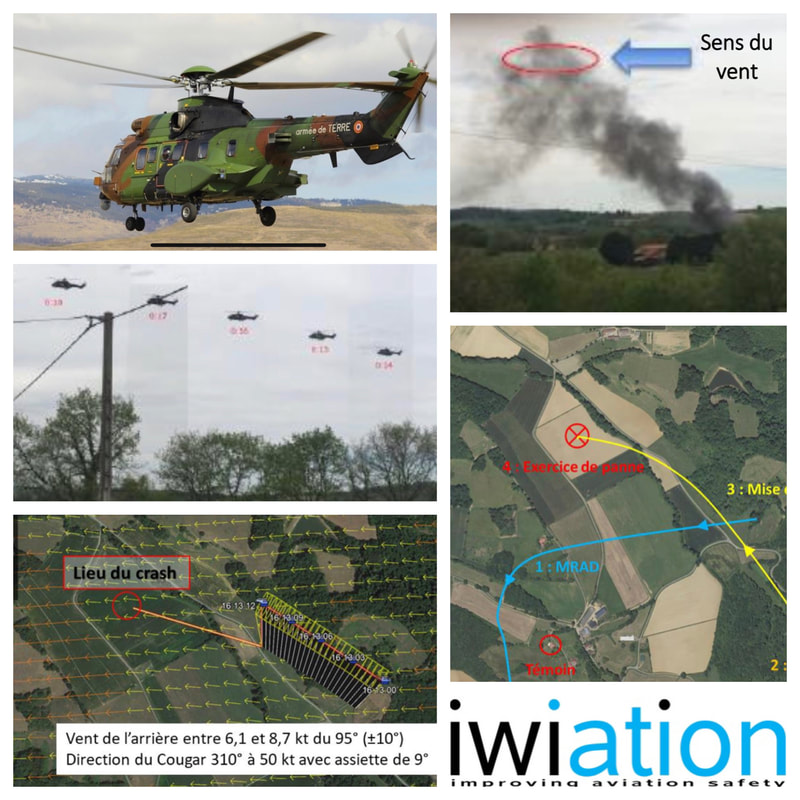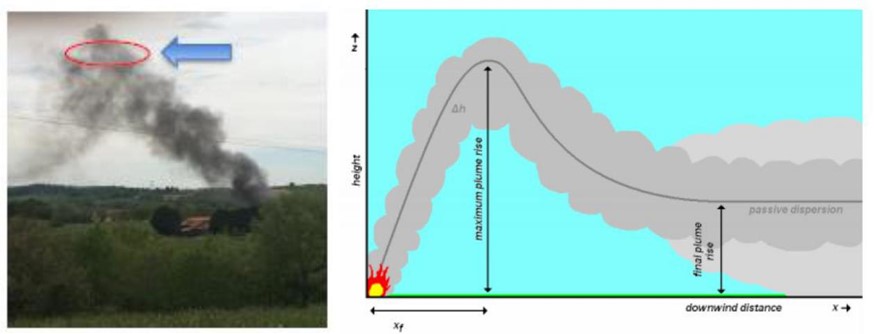French ALAT Cougar Crashed After Entering VRS When Coming into Hover
On 15 April 2020, a French Army ALAT (Army Light Aviation) Airbus Cougar NG AS332M1e 2336 of the 5th Combat Helicopter Regiment (5e RHC), based in Pau, was destroyed during a hoist training flight northeast of Tarbes. Two occupants died, two were seriously injured and three suffered minor injuries.
History of the Flight
Investigators of the BEA-Etat (BEA-E) explain in their safety investigation report, issued in French only on 20 September 2021, that the student pilot has just 77 flight hours on Cougar and 592 hours in total. He was a former Puma pilot who started his conversion onto the Cougar in November 2019. The instructor pilot had 2,060 hours on type and 3,251 hours in total.
The crew had completed the hoist training and the instructor pilot had commenced an emergency drill exercise involving a simulated failure of two alternators while hovering. The BEA-E explain that the instructor intended to demonstrate that after a double alternator failure the helicopter would need to accelerate forwards as a peculiarity of the Cougar is that N1 is restricted to 85% after a double alternator failure. They note that no double alternator failure had ever occurred in reality on the ALAT Cougar fleet and there was no formalised emergency procedure for this event, yet this emergency exercise was a common one within the ALAT Cougar community. The investigators also note that the student pilot was now manually flying the helicopter, while the autopilot had been coupled for the earlier exercises.
Main rotor pitch reduced, the aircraft lost altitude and crashed vertically in a field with a slight nose-up attitude. Just before impact, in ground effect, the rotor became effective again and the helicopter briefly returned to a hover. This occurred with very high torque that resulted in a loss of directional control and during this the helicopter yawed and tipped on to its right hand side.
There was a post crash fire, believed to have been due to hydraulic fluid leaking onto hot engine components after the firewall suffered impact damage. As is all too common in helicopter accidents the Emergency Locator Transmitter (ELT) did not signal as the wiring to the antenna was severed.
Survivability was adversely affected because:
Only one in seven crew members wore a flight suit. Army culture favours the wearing of combat fatigues, including in flight.
These fatigues were not flame retardant. Furthermore only the flight crew were seated in crashworthy seats. Injuries to the flight engineer were also consistent with being unstrapped, a necessity to reach some controls.
The BEA-E Safety Investigation
The helicopter was not equipped with any crash-protected flight recorders (although the ALAT Cougar fleet is expected to have these in incorporated in the future). The embodiment had been delayed because an audio mixer component had become obsolescent.
The helicopter was fitted with SIT-ALAT (French Army Light Aviation Terminal Information System) which provides a moving map display and saves GPS data. Unfortunately this unit was destroyed in the fire.
A reconstruction of the trajectory was however possible with the assistance of specialists iwiation Gmbh. The flight path was reconstructed based on eyewitness video information (although trees obscured the decent). Just prior to coming into the hover the helicopter was at c 300 ft AGL, at a heading of 310º.
The witness video shows that the helicopter is moving at a ground speed of 47 kt.
This means the crew would have needed to briefly pitch the nose up c15° to slow the helicopter and enter a hover. Crucially:
This attitude reduces speed quickly and also decreases lift.
The wind direction and wind speed was verified based on a 3D reconstruction of the column of smoke from the wreckage.
Analysis of the videos allows us to estimate a wind with a force between 6.1 and 8.7 kt coming from 95°. The analysis took into account the influence of the relief of the area on the wind and the margin of error is of the order of plus or minus 10 °. This analytical result is consistent with meteorological observations in the area at the same time.
During the earlier training the wind had been negligible and the crew had not identified they now had a tailwind. Consequently with the unperceived tailwind and a momentary loss of lift decelerating, the helicopter entered the hover for about a second before beginning to descend. Simulations initiate a c 500 ft / min rate of descent initially. The engines accelerated to 97% N1 and the pilots increased main rotor pitch to counteract the decent. The BEA-E conclude that moments later when pitch was reduced the helicopter entered a vortex ring state, however that implies a very rapid increase in rate of descent:
This aerodynamic phenomenon [i.e. VRS] is relatively rare. It is likely to occur in flight at low speeds, less than 30 kt, with a rate of descent close to the induced speed. This induced speed varies depending in particular on the rotor diameter, the number of blades and the mass of the helicopter.
Airbus Helicopters estimates that this speed is greater than 1,200 ft / min on a Cougar.
The BEA-E go on to say:
The height of the hover in downwind conditions at the start of the exercise was insufficient for the crew to have time to leave this vortex phase before reaching the ground.
The BEA-E comment that:
The event occurs at the end of the session while the crew is on the return to base. The [student] pilot demonstrated his skills throughout the sortie, performing the various exercises successfully. Under these conditions, it is possible that the crew suffered a loss of attention at the end of the flight while on the return trip. This drop in attention at the end of the flight may have been accentuated by the perceived ease of this exercise.
Additionally, the student’s performance had left the instructor confident in their ability, but…
…overconfidence may have caused a drop in monitor attention and contributed to a lack of control and correction.
The investigators note that the unit had previously lost another helicopter in a fatal mid air collision in Mali on 25 November 2019. “This resulted in organizational disruption in the functioning of the unit.” Additionally a month earlier…
…France entered general confinement to deal with the Covid-19 pandemic. This unprecedented situation had a strong impact on the organization of the 5eRHC. A business continuity plan has been put in place with the objective of reducing the workforce physically present in the regiment to below 50%. Each week, half of the crews took turns on duty.
The cancellation of non-essential missions or missions outside the regiment made it possible to refocus the activity of the squadron on the training of pilots and in particular of the youngest.
However a “chronic lack” of instructors increased the workload and fatigue of the remaining instructors (though BEA-E do not quantify that fatigue).
Furthermore:
The knowledge of VRS is theoretical only…. The non-existent [practical] training of the crews in the vortex phenomenon does not allow them to acquire skills in the detection and recovery of this phenomenon.
Furthermore, the simulator had been unavailable for several years, reducing training opportunities.
BEA-E Conclusions
The main cause of the accident was the crew’s lack of awareness that the exercise was being carried out under dynamic vortex conditions, an insidious phenomenon difficult to detect and with consequences that were often poorly controlled. The wind conditions change shortly before the exercise is carried out and the wind is established by the rear of the helicopter with a force greater than 5 kt.
Systemic contributory factors where:
- the lack of standardization in training for failure procedures that can be used in instruction;
- an underestimation of the risk of a vortex linked to a low occurrence of the phenomenon, only theoretical knowledge by the pilots and a less well-known dynamic vortex;
- a simulator for the Cougar and Puma family, down for many months;
- an inability to train in the vortex phenomenon, in real life or in a simulator.
Human factors included:
- the absence of perception by the crew of information concerning the evolution of the wind;
- the crew’s underestimation of the risk of performing the exercise;
- a significant cognitive load for the student pilot;
- an exercise perceived by the instructor as simple at the end of the flight;
- overconfidence in the student pilot on the part of the instructor;
- a context causing crew fatigue;
- a time pressure linked to the approach of the end of the time allocated for the flight;
- a lack of knowledge of the specific case of the dynamic vortex;
- the absence of an official ALAT procedure for training in the simulated failure procedure of the two alternators;.
The BEA-E raised 19 safety recommendations.
Safety Resources
The European Safety Promotion Network Rotorcraft (ESPN-R) has a helicopter safety discussion group on LinkedIn. You may also find these Aerossurance articles of interest:
- Human Factors of a Mali Mid Air Collision
- Vortex Ring State: Virginia State Police Bell 407 Fatal Accident
- Grand Canyon Air Tour Tragic Tailwind Landing Accident
- US Air Ambulance Near Miss with Zip Wire and High ROD Impact at High Density Altitude
- A319 / Cougar Airprox at MRS: ATC Busy, Failed Transponder and Helicopter Filtered From Radar
- Merlin Night Airprox: Systemic Issues
- Culture and CFIT in Côte d’Ivoire (ALAT SA342M Gazelle)
- Military SAR H225M Caracal Double Hoist Fatality Accident
- SAR AW101 Roll-Over: Entry Into Service Involved “Persistently Elevated and Confusing Operational Risk”
- RCAF Chinook LOC Under Investigation
- A Second from Disaster: RNoAF C-130J Near CFIT
- Firefighting AW139 Loss of Control and Tree Impact
- Loss of RAF Nimrod MR2 XV230 and the Haddon-Cave Review
- RCAF Production Pressures Compromised Culture
- Investigation into F-22A Take Off Accident Highlights a Cultural Issue
- ‘Procedural Drift’: Lynx CFIT in Afghanistan
- Crashworthiness and a Fiery Frisco US HEMS Accident
- AW139 Brownout Accident with the Nigerian VP Aboard
- AAIB Report on 2013 Sumburgh Helicopter Accident
- Hard Landing after VRS on Approach to a Hospital Site
- Mi-26T Arctic VRS Accident 28 November 2018
- SAR Helicopter Loss of Control at Night: ATSB Report
- Swedish SAR AW139 Damaged in Aborted Take-off Training Exercise
- Latent Engine Defect Downs R44: NR Dropped to Zero During Autorotation
- UPDATE 2 July 2022: Fatal EC130B4 Water Impact in the Tennessee River after “Entry to VRS” Say NTSB




Recent Comments